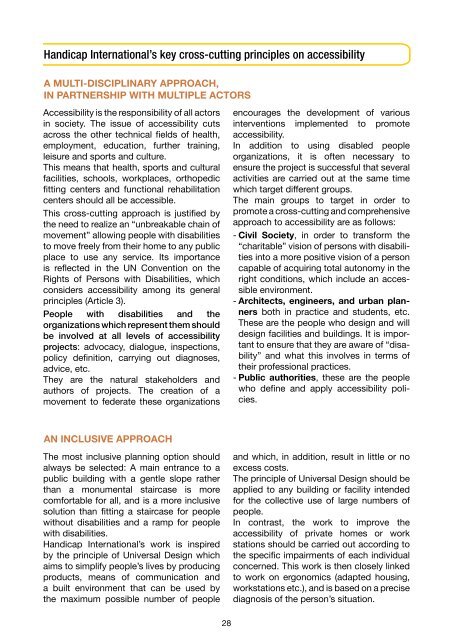Accessibility - Handicap International
Accessibility - Handicap International
Accessibility - Handicap International
You also want an ePaper? Increase the reach of your titles
YUMPU automatically turns print PDFs into web optimized ePapers that Google loves.
<strong>Handicap</strong> <strong>International</strong>’s key cross-cutting principles on accessibility<br />
A multi-disciplinary approach,<br />
in partnership with multiple actors<br />
<strong>Accessibility</strong> is the responsibility of all actors<br />
in society. The issue of accessibility cuts<br />
across the other technical fields of health,<br />
employment, education, further training,<br />
leisure and sports and culture.<br />
This means that health, sports and cultural<br />
facilities, schools, workplaces, orthopedic<br />
fitting centers and functional rehabilitation<br />
centers should all be accessible.<br />
This cross-cutting approach is justified by<br />
the need to realize an “unbreakable chain of<br />
movement” allowing people with disabilities<br />
to move freely from their home to any public<br />
place to use any service. Its importance<br />
is reflected in the UN Convention on the<br />
Rights of Persons with Disabilities, which<br />
considers accessibility among its general<br />
principles (Article 3).<br />
People with disabilities and the<br />
organizations which represent them should<br />
be involved at all levels of accessibility<br />
projects: advocacy, dialogue, inspections,<br />
policy definition, carrying out diagnoses,<br />
advice, etc.<br />
They are the natural stakeholders and<br />
authors of projects. The creation of a<br />
movement to federate these organizations<br />
encourages the development of various<br />
interventions implemented to promote<br />
accessibility.<br />
In addition to using disabled people<br />
organizations, it is often necessary to<br />
ensure the project is successful that several<br />
activities are carried out at the same time<br />
which target different groups.<br />
The main groups to target in order to<br />
promote a cross-cutting and comprehensive<br />
approach to accessibility are as follows:<br />
- Civil Society, in order to transform the<br />
“charitable” vision of persons with disabilities<br />
into a more positive vision of a person<br />
capable of acquiring total autonomy in the<br />
right conditions, which include an accessible<br />
environment.<br />
- Architects, engineers, and urban planners<br />
both in practice and students, etc.<br />
These are the people who design and will<br />
design facilities and buildings. It is important<br />
to ensure that they are aware of “disability”<br />
and what this involves in terms of<br />
their professional practices.<br />
- Public authorities, these are the people<br />
who define and apply accessibility policies.<br />
An inclusive approach<br />
The most inclusive planning option should<br />
always be selected: A main entrance to a<br />
public building with a gentle slope rather<br />
than a monumental staircase is more<br />
comfortable for all, and is a more inclusive<br />
solution than fitting a staircase for people<br />
without disabilities and a ramp for people<br />
with disabilities.<br />
<strong>Handicap</strong> <strong>International</strong>’s work is inspired<br />
by the principle of Universal Design which<br />
aims to simplify people’s lives by producing<br />
products, means of communication and<br />
a built environment that can be used by<br />
the maximum possible number of people<br />
and which, in addition, result in little or no<br />
excess costs.<br />
The principle of Universal Design should be<br />
applied to any building or facility intended<br />
for the collective use of large numbers of<br />
people.<br />
In contrast, the work to improve the<br />
accessibility of private homes or work<br />
stations should be carried out according to<br />
the specific impairments of each individual<br />
concerned. This work is then closely linked<br />
to work on ergonomics (adapted housing,<br />
workstations etc.), and is based on a precise<br />
diagnosis of the person’s situation.<br />
28

















